Something funny’s going on, out in Ukraine (and it’s not just the president). As JOHN GIMLETTE discovers, both Lviv and Kiev have become perceptibly cool, and a little outrageous.
Every day in Lviv there’s a little revolution, and it’s mostly fun. Counter-culture now rules, or at least inspires. Take the restaurants, for example. One of the latest, ‘Ukrainian Food Art’, has a see-through piano that plays itself, and a shark-tank that rises up through several floors. Another, called ‘The Masonic’, has a secret entrance that leads through a grungy bedsit into a magnificent brasserie with a car suspended from its ceiling.
Each night Lviv goes to bed a little less Soviet, and the city gets younger and younger. Colour is returning to the hotels, and the shops are now full of exotica like drones and iPods and fancy knickers. Even the city’s police look like teenagers in their European cars and spiffy new outfits. ‘We got rid of the old fatties,’ said our guide, Tymor, ‘in the 2014 uprising. Too corrupt, too pro-Russian.’
Perhaps the most quirky place of all is Livy Bereh (or ‘Left Bank’) which was once an underground river. With its whitewashed antiques, it’s now the haunt of The Beautiful People. The cocktails are served in fire-extinguishers, and the barman wears a white leather mask. ‘Ukrainians have become a bit anarchic,’ admitted Tymor, ‘We’re re-writing the rules.’
Ukraine’s metamorphosis isn’t always so obvious. Our week-long family trip began with the overnight sleeper from Kiev. The aging train was like the Soviet Union itself: ponderous, orderly and prim. We slept on starched white sheets, and an attendant in a quilted greatcoat brought us glasses of tea. Outside, the snowy black steppes flickered past, and then, at dawn, a film-set appeared. It was the grand old station of Lemburg – or Lviv – circa 1900.
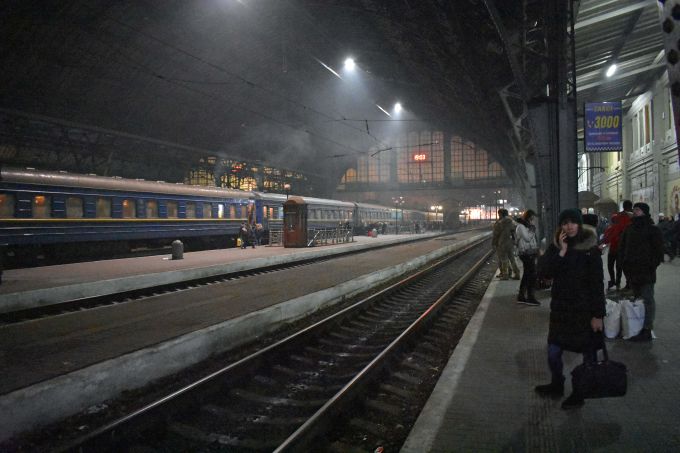
Waiting for the Kiev train at Lviv station
In today’s Lviv, everything’s possible, and anything goes. I’d often see the same angel flying round the city on her roller skates. In the giddy Noughties, all the big brands arrived, along with onesies, Private Clubs, and Armani dog-coats. We even found a cat café, with a retinue of twenty moggies. But strangest of all was a network of beerhalls deep beneath the cobbles, known as ‘The Bunker’. You need a password to get in (‘Glory to Ukraine!’) and all the staff are dressed as guerrillas. But it’s cheap and raucous, and there’s a Vladimir Putin punchbag.
In this revolution, time sometimes goes backwards, and a beautiful city has reappeared. With its cobbled streets and luminous classical facades, I half-expected to see Habsburgs again. They’ve left so much of themselves behind: kiosks, palatial cafés, titanic statues, parks, and a twinkling opera house. Meanwhile, the chocolate’s as good as ever, although, these days, it comes in all shapes and sizes, from a pair of boobs to an AK47.
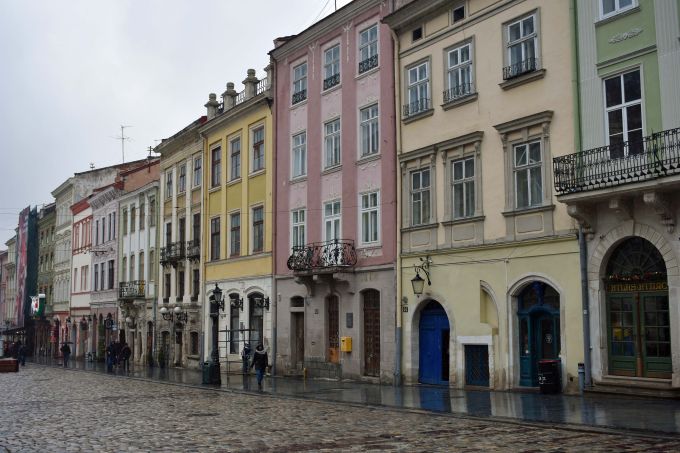
The coloured streets of Old Habsburg, Lviv
Of course, not everyone’s out, enjoying cocktails. Twice we made trips into the country. I loved the castles, particularly Olesko (with its giant canvas, ‘The Battle of Vienna, 1682’). We also met a jolly herder, with a pet eagle on his arm. But elsewhere, the villages could look uncomfortably medieval. It was a reminder that Ukrainians are the poorest people in Europe, with almost a quarter on their uppers.
Our journey back to Kiev was full of surprises. The station felt like a film again, with all those soldiers heading back to the front (Ukraine is now in the fifth year of its low-grade conflict, far off in the Donbass). But then our train arrived, now looking sleek and futuristic. On board, we ate quinoa salads, and the conductress wore a miniskirt and boots as if it were a starship. Five hours later, we were swooping into the capital.
Initially, Kiev was only as strange as I’d expected. Fishermen potter around on its great frozen river, and the outer suburbs – pulverised in 1941 – now look like distant plateaus of concrete. In places, it seems only the monasteries survived, with their gigantic onions of gold. Our favourite was Kyevo-Pecherska Lavra, or the Monastery of Caves, a sprawling complex of tunnels and mummies. In the eleventh century, hermits often had themselves entombed here – alive – foregoing forever human company and the light of day.
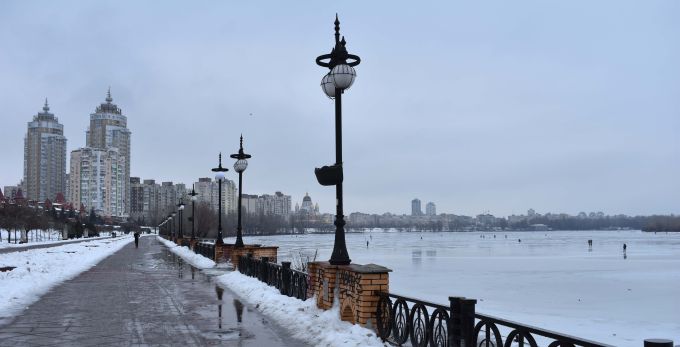
Fishermen of the frozen river Dnipro, Kiev
What I’d not expected was the sheer audacity of the new Kiev. Everywhere there were bright designs and flashy cars. It’s hard to believe it was ever Soviet. Even Stalin’s great masterpiece, Kreschatky Street – once overbearing – is now discernibly hip. It’s the same with Tsum, the old state emporium. Once famously drab, it’s now a sort of Harrods, except bolder and brasher. But then – here – exuberance is freedom, and everyone’s flaunting what few can afford.
The overthrow of tyranny is a popular theme, even in restaurants. Some are fabulously chic (and yet we seldom paid more than £12 a head). My favourite was Ostannya Barykada, or ‘The Last Barricade’, a glorious underground lair of chrome, polished concrete and local produce (even the cheddar). Then there’s Veterano Pizza, run by ex-soldiers, and Spotykach, which gently mocks the Soviet era. Surprisingly, its food is inspired, if slightly surreal. I had ‘herring éclairs’ and borscht served – cosmonaut-style – in a squeezy tube.
It’s hard not to be swept up in the excitement. I’ve never known change so passionate and rapid. Kiev even has its own new ‘Latin quarter’, called Vozdvizhenska. With its grand eateries and funky turrets, it’s hard to know what you call this style. Baroque, perhaps, with a dash of Lego. But for many, it’s not just about oysters and art. Only a few yards from Tsum is a shop for ‘Volunteers’. Here you can buy a steel helmet (£3) and a gasmask (£15), and everything you’d need to go to war.
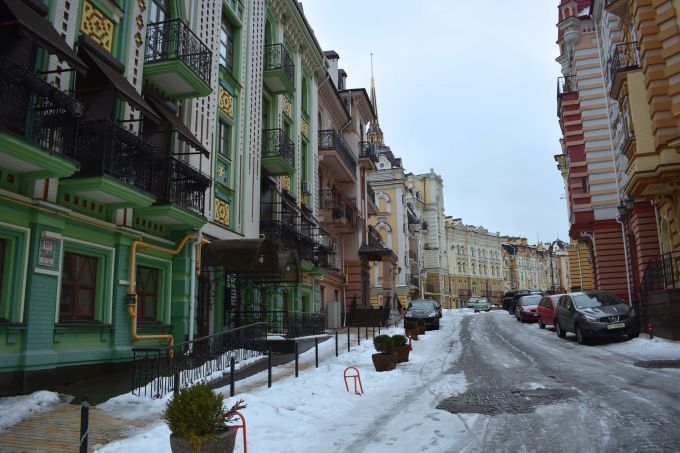
The new baroque of Vozdvizhenska, Kiev
At the heart of this great cultural revolt is Maydan Nezalezhnosti (Independence Square). We often found ourselves here, amongst its pedlars and buskers. In 2014, half the city turned up, to rail at a president seen as Putin’s puppet. Around the square you can still see pictures of their tented camp and the burning barricades. Over 100 were killed, and 15,000 injured. A tiny museum has recently opened, to commemorate their sacrifice (and we were the first to sign its remembrance wall).
Before leaving, we visited another two unforgettable museums. The first was a complex of 16 halls beneath the gigantic Motherland Monument. Here, brilliantly displayed, is a terrible century. Over 8 million Ukrainians died in WW2, leaving behind a gruelling residue of hardware, including guns, a guillotine and a mill for crushing bones.
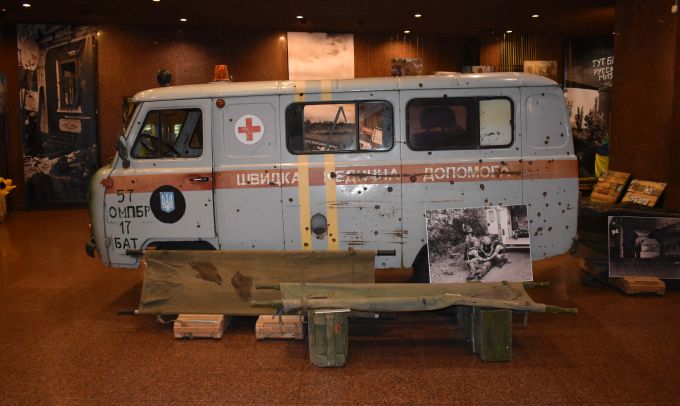
Bullet-riddled ambulance at the War Museum, Kiev
Equally poignant is the Chernobyl Museum. Thousands perished in the clean-up, and all that remains of them are snapshots and watches, and their pitiful medals. Seeing all this, you understand Ukraine a little better, its anger and its passion.
Our last night, we ate at Zhizn Zamechatelnykh Lyudey (‘Lives of the Great’). Dominated by a gorgeous wall of books, it was indefinably cool (think Shoreditch and Tudor, all rolled into one). The locals – mostly young and techie – were in party mood, but were puzzled by Brexit. Why were we leaving? For them, the EU’s banner is a rallying point, a rebel flag.
But we did at least promise to return. Who knows what the next few years will bring. Weekenders, perhaps? Less poverty and ever more ingenuity? Meanwhile, I have my souvenirs, a curiously quirky haul: some Carpathian honey, a little tank made of bullets, a roll of Putin loo-paper, and a bottle of delicious lemon vodka, otherwise known as ‘Hand Grenade’.
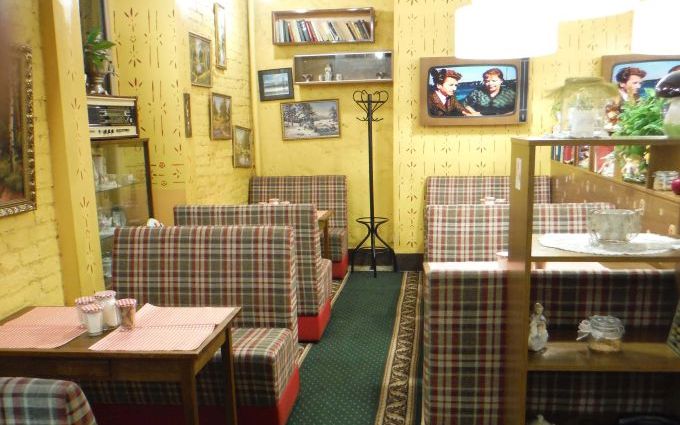
A Soviet-nostalgia cafe, Kiev
ESSENTIALS
John Gimlette travelled as a guest of Baltic Travel Company (0208 233 2875; www.baltictravelcompany.com). They offer a 7-day escorted tour of Kiev and Lviv from £895 pp based on two sharing. Price includes international flights; private transfers; guides; and hotels.
When to go
It’s like New York: hot summers and chilly winters. But don’t let the cold put you off; the cities are bustling, and the nights alive.
Did you know?
Kiev’s palatial metro opened in 1960, and is the world’s second deepest (after Pyongyang). Tickets cost about 30p.
John Gimlette is the author of ‘Elephant Complex; Travels in Sri Lanka’ (Riverrun £9.99)
If this story inspired you, learn more about the Eastern European holidays we have, and find your next travel destination. All rights to Baltic Travel Company.
This entry was posted on Friday, May 10th, 2019 at 1:00 pm; on the subject of Eastern Europe, Ukraine.